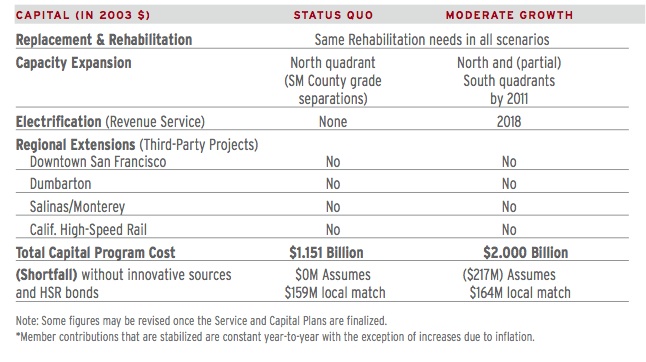Extensions from Caltrain or, perhaps by Caltrain, but not extensions of Caltrain.
Huh, I must be slow because I just realized what you might be talking about. Are you saying that these extensions aren't extensions from the current Caltrain route and service because it hasn't been discussed about how Caltrain might integrate them into the system if they should happen? Are you suggesting the possibility that a northbound Salinas train would terminate in San Jose where passengers would have to transfer to a proper Caltrain train (and similarly for any Dumbarton route)?
If that's the case, I guess I can see it making some sense, especially given the big electrification kick that Caltrain's on. I was thinking they would be integrated into the rest of the service so you could go from East Bay or Salinas directly into San Francisco, but maybe that's not in the cards.
If and when Caltrain goes to EMUs, I was thinking that it was going to free up a lot of locos and coaches. I was initially thinking that any usable rolling stock would be sold, but perhaps they could be used on these routes.
Sacramento-Redding considerations:
- Isn't the line single-track almost all of the way? If so, would double-tracking it make it more attractive for additional passenger rail service?
- Chico State is in Chico (duh!). Would starting a weekend service attract enough college students to build up a ridership base in a Sacramento-Redding corridor?
- Would a Redding-Chico-Marysville/Yuba City to Sacramento service have convenient connections to San Joaquin and/or Capitol Corridor services, as well as to the CZ (especially to trains going to and coming from the east)?
You raise some interesting points.
1. Yes, it is single track for a great distance. Double-tracking would probably make it more appealing for passenger service, but that's an expensive option. I think we would see more sidings first (and there is a lot of flat ag land to possibly accommodate sidings).
2. Yes, Chico State is in Chico. Caltrans states it is one of the factors suggesting that there might be enough demand in increased train service on the route. It's also interesting that Redding has had more train passengers than Chico, but Chico has had more passengers overall (which logically must be due to Thruway service).
The station is fairly close to the university too. I think there's potential there (especially after riding back a very crowded bus back to Chico after Thanksgiving 2007).
I don't know about a weekend service because daily service seems more convenient. Does Amtrak do this in other parts of the country? I know there are a couple of weekend stops (like Old Town San Diego).
3. I would hope that any Redding-SAC train would have convenient connections to both Capitol Corridor and San Joaquins. In terms of how the service would be extended, I've thought about the possibility of extending one of the SAC-BFD San Joaquins or having Capitol Corridor run daily up to Redding (kinda like its one or two daily trips out to Auburn). I can also see problems with those routings.
I would hope for a convenient connection to California Zephyr, but I think there are limits to what a single daily train can do. Caltrans states the Thruway bus runs would supplement the train by running at different times during the day.
Right now, there's a 6:20 a.m. Thruway from Redding to Sacramento (with a 7:55 a.m. Chico stop) that arrives an hour before eastbound Zephyr's 11:09 a.m. SAC stop. I was thinking that it is too close to the Starlight run, but it's really about 4 hours apart. Although it's an early start from Redding, it does get people to the Bay Area at midday.
The westbound Zephyr arrives in SAC at 3:13 p.m. and a 6:30 p.m. bus takes passengers north. I guess the bus could be supplanted by a train.




